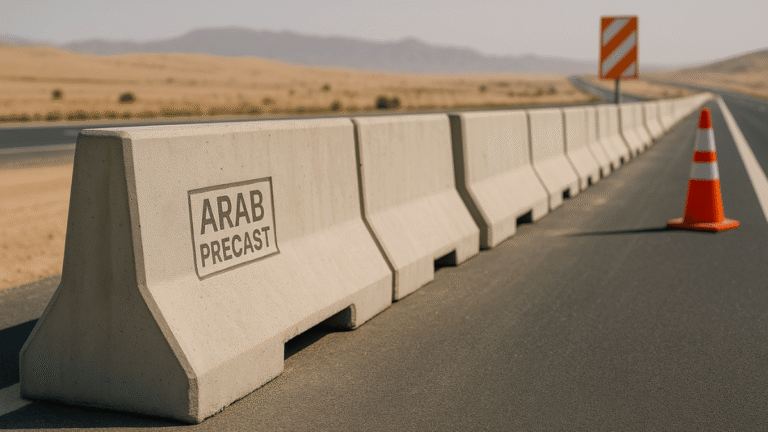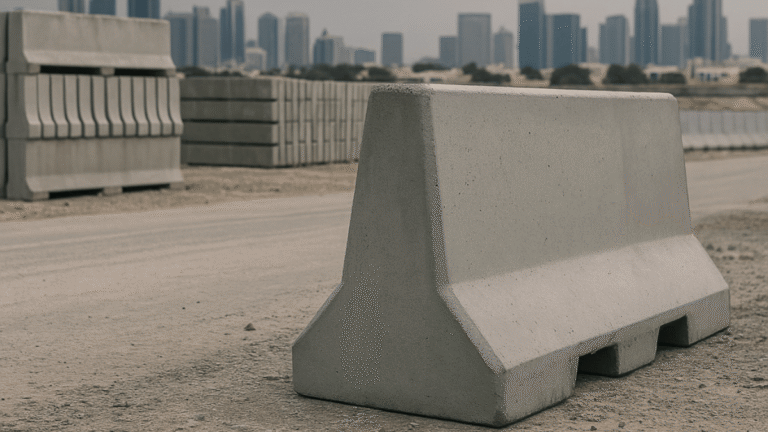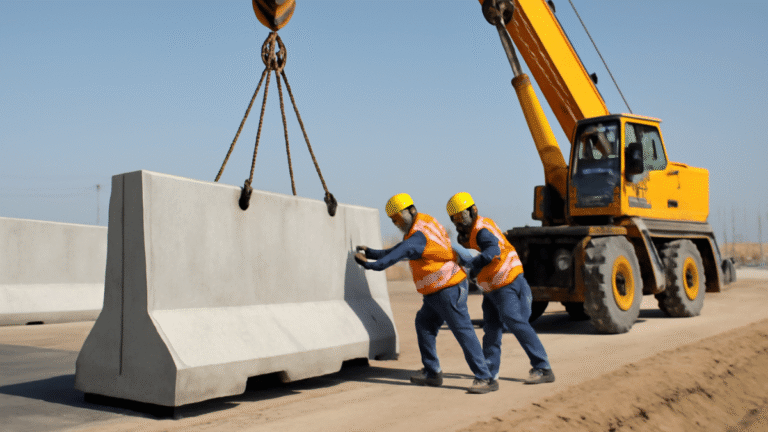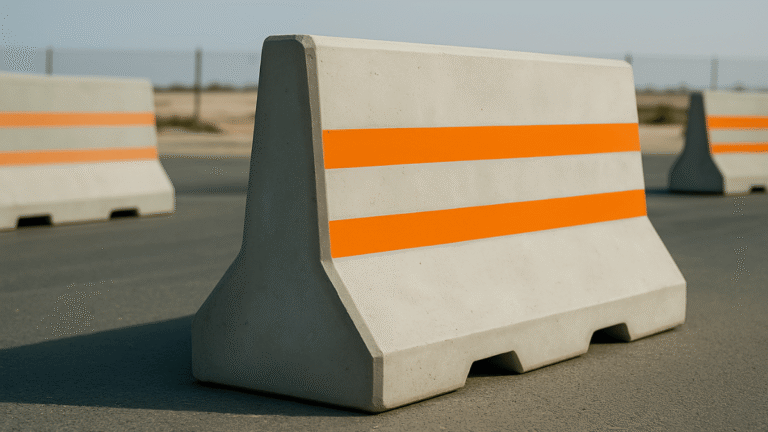Precast vs Cast-in-Place Concrete Barriers: Which is Right for Your UAE Project?
The UAE’s rapid growth in urban infrastructure, including highways, roads, and construction zones, has heightened the need for effective road safety solutions. Among the most important safety features on any road are concrete barriers – designed to separate lanes, protect workers, and prevent accidents. Whether it’s for a bustling highway or a temporary construction site, choosing the right concrete barrier can significantly impact the success of your project, both in terms of safety and efficiency.
If you’re a civil contractor, project manager, or construction consultant in the UAE, you’re likely aware of the two most common types of barriers used in road construction: precast concrete barriers and cast-in-place concrete barriers. But with both options available, how do you decide which one is best for your project?
In this post, we’ll break down the key differences between precast and cast-in-place concrete barriers, exploring the pros and cons of each and helping you make an informed decision about concrete barriers for your UAE project.
Precast Concrete Barriers: Fast, Durable, and Ready for Installation
Precast concrete barriers are manufactured in a controlled environment (usually in a factory or precast yard), then transported to the site where they are quickly installed. These barriers are created using specific molds to ensure consistency and quality.
Benefits of Precast Concrete Barriers
1. Speed of Installation
One of the most significant advantages of precast concrete barriers is the speed of installation. Since these barriers are already cast and hardened in the factory, they can be quickly transported to the site and placed, saving you valuable time on the job. This is especially beneficial for large-scale projects or areas with high traffic where downtime should be minimized.
2. Quality Control
Precast barriers are created under strict quality control in a factory setting. This ensures that the precast concrete barriers meet consistent standards for durability, strength, and size. This factory-controlled environment is ideal for achieving precise measurements and uniformity, which is crucial for maintaining safety standards in construction zones.
3. Cost-Effective Over Time
While precast barriers may have a higher initial cost due to transportation and handling, their long-term durability and low maintenance make them a cost-effective choice in the long run. These barriers are designed to withstand harsh environmental conditions, ensuring they perform well for many years.
4. Flexibility in Design
Precast barriers come in various shapes and sizes. For example, Jersey barriers, median barriers, and traffic barriers can be selected depending on the specific needs of the project. Additionally, if you’re looking for a temporary solution, precast barriers can be easily relocated and reused, offering excellent flexibility.
Challenges of Precast Concrete Barriers
Transportation Costs
Since precast concrete barriers are manufactured off-site, transportation costs can add up, especially for large or heavy barriers. If your project is located in a remote area, these transportation fees could be considerable.
Limited Customization On-Site
Once the precast barriers are manufactured, any modifications or adjustments need to be made in the factory. This limits flexibility if you need on-site alterations to fit the exact specifications of your project.
Cast-in-Place Concrete Barriers: Customizable and Strong
Cast-in-place concrete barriers are constructed directly at the site by pouring wet concrete into pre-formed molds or frames. This method allows for more design flexibility compared to precast options.
Benefits of Cast-in-Place Concrete Barriers
1. Customization
The major advantage of cast-in-place concrete barriers is the ability to create custom designs on-site. Whether it’s for a unique road curvature, slope, or specific strength requirements, cast-in-place barriers can be adjusted to fit the exact needs of the site. This makes them ideal for roads with complex geometries or unusual layouts.
2. Strong Bond with Substrate
Cast-in-place barriers are poured directly into the ground, forming a seamless bond with the surrounding substrate. This creates a stronger and more stable connection, which is especially beneficial for areas that experience heavy traffic, vibrations, or extreme weather conditions.
3. No Transportation Costs
Since cast-in-place barriers are poured on-site, there are no transportation costs. This can be a significant cost-saving, especially for large or remote projects where transporting precast barriers could become expensive.
4. Site-Specific Adjustments
The ability to adjust the barrier design as the project progresses is a significant advantage of cast-in-place barriers. You can make changes to the design, thickness, or other specifications as per the evolving needs of the construction site.
Challenges of Cast-in-Place Concrete Barriers
1. Longer Installation Time
Cast-in-place barriers require more time to construct since they need to be poured, set, and cured. This process can be time-consuming, especially in large-scale projects where numerous barriers need to be installed.
2. Labor-Intensive
Since the barriers are created on-site, cast-in-place barriers require more labor and expertise, which can drive up the overall project cost. This could be a concern if you’re working within a tight budget or timeline.
3. Weather Sensitivity
The curing process of cast-in-place barriers is highly dependent on weather conditions. Heavy rain, extreme heat, or high humidity can delay the curing process and extend the installation timeline.
Precast vs Cast-in-Place Concrete Barriers: A Comparison
To help you make a more informed decision, here’s a side-by-side comparison of precast concrete barriers and cast-in-place concrete barriers:
| Feature | Precast Concrete Barriers | Cast-in-Place Concrete Barriers |
|---|---|---|
| Installation Speed | Faster, as barriers are pre-manufactured and ready to install | Slower, as barriers need to be poured and cured on-site |
| Customization | Limited to factory design; alterations require remanufacturing | Highly customizable to fit site-specific designs |
| Cost | Higher initial cost due to transportation and handling | Potentially lower cost due to no transportation fees |
| Labor Requirements | Minimal on-site labor needed | More labor-intensive due to on-site pouring and curing |
| Durability | High durability and low maintenance | Stronger bond with substrate, highly durable |
| Flexibility | Less flexible once installed | Highly flexible for site-specific needs and adjustments |
| Weather Sensitivity | Minimal impact (manufactured in controlled environments) | Affected by weather conditions during curing |
| Compliance with UAE Standards | Municipality approved, compliant with safety standards | Municipality approved with custom design options |
Real-World Example: Precast vs Cast-in-Place in UAE
Example: Dubai Metro Project
In the Dubai Metro Project, both precast concrete barriers and cast-in-place concrete barriers were used to ensure safety and efficiency. For the main highways surrounding the metro construction zone, precast concrete barriers were selected for their speed and ease of installation. These barriers helped separate traffic from construction zones, ensuring both worker and driver safety.
However, in areas with unique road layouts, such as those with tight curves and steep slopes, cast-in-place barriers were used. These barriers provided the necessary customization to fit the exact dimensions of the site while ensuring a strong bond with the foundation.
The combination of both barrier types allowed the Dubai Metro project to maximize safety, efficiency, and cost-effectiveness while meeting the unique requirements of each section of the construction zone.
Conclusion: Which Barrier is Right for Your UAE Project?
Choosing between precast concrete barriers and cast-in-place concrete barriers largely depends on the specific needs of your project. If you’re working on a high-speed highway or need quick installation, precast concrete barriers may be the best solution. On the other hand, if your project involves custom designs, complex terrains, or the need for long-term durability, cast-in-place barriers may be more suitable.
To ensure your project meets both UAE safety standards and your budgetary requirements, it’s crucial to carefully evaluate your needs. If you’re unsure which option is best for you, the team at Arab Precast is here to help. We provide municipality-approved barriers tailored to meet the specific demands of the UAE market.
Contact us today to discuss your next project and find the best solution for your road safety concrete barriers needs in UAE!
FAQ: Precast vs Cast-in-Place Concrete Barriers
What are the key differences between precast and cast-in-place concrete barriers?
Precast concrete barriers are manufactured off-site and delivered ready for installation, offering faster deployment and consistency. Cast-in-place barriers are poured and set on-site, providing more flexibility for custom designs but requiring more labor and time to install.
Which barrier is better for a high-traffic highway in the UAE?
Precast concrete barriers are ideal for high-traffic highways due to their quick installation and durability. They can handle high impact forces and provide consistent performance in busy environments.
Can I customize cast-in-place concrete barriers for my project?
Yes, cast-in-place barriers offer flexibility for custom designs, allowing for modifications to fit specific road layouts or environmental conditions.





